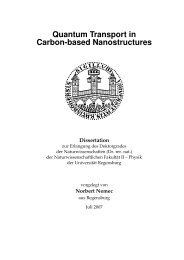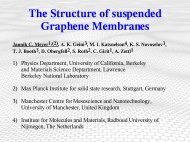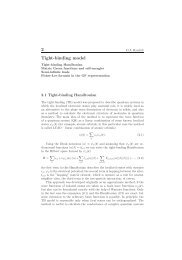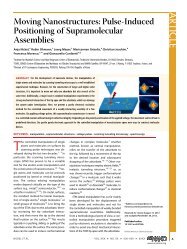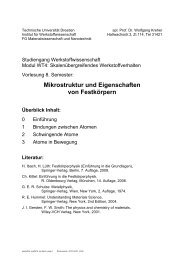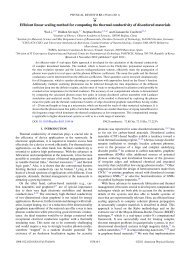4 Coulomb blockade
4 Coulomb blockade
4 Coulomb blockade
You also want an ePaper? Increase the reach of your titles
YUMPU automatically turns print PDFs into web optimized ePapers that Google loves.
88 4 <strong>Coulomb</strong> <strong>blockade</strong><br />
Before considering the particular cases, let us perform all possible general<br />
calculations in (4.62). First of all, the tunneling Hamiltonian is the sum of<br />
left and right parts, we are interested only in the processes, which transfer<br />
electrons from the left to the right, and include one tunneling through the<br />
right junction and one tunneling through the left junction. Then, the initial<br />
state is a mixed state with different probabilities for the states |k〉 and |q〉 to be<br />
occupied or empty, following the tunneling theory we introduce the sum over<br />
all possible configurations of the initial state with corresponding occupation<br />
probabilities (distribution functions) f 0 L (Ek) andf 0 R (Eq). Thus, we obtain<br />
Γ (2) 2π<br />
L→R =<br />
¯h<br />
<br />
<br />
<br />
× <br />
<br />
<br />
λ<br />
fq<br />
<br />
k∈L,q∈R<br />
f 0 L(Ek) 1 − f 0 R(Eq) δ(Ei − Ef )<br />
<br />
<br />
ˆ <br />
<br />
HTR<br />
λ λ ˆ <br />
<br />
HTL<br />
ik<br />
<br />
+<br />
fq<br />
Eλ − Ei<br />
<br />
<br />
ˆ <br />
<br />
HTL<br />
λ λ ˆ <br />
<br />
HTR<br />
ik<br />
2<br />
<br />
<br />
<br />
. (4.63)<br />
<br />
The intermediate states |λ〉 are the states with one extra electron (or<br />
without one electron, e.g. with one extra hole) in the central system. Note,<br />
that the only thing we assume is that the charge of the central system is the<br />
same in the initial and the final states (and ±e in the virtual intermediate<br />
state). However the state and energy of the central system can change after<br />
tunneling event. In the last case the process is called inelastic cotunneling.<br />
Up to now, all our calculation is general, now it is reasonable to consider<br />
separately the contributions of inelastic and elastic cotunneling.<br />
4.5.1 Inelastic cotunneling<br />
Consider the final state as the state with one electron transferred from the<br />
state k in the left lead to the state q in the right lead with the change of the<br />
state of the system from |λi〉 with electron in the state α and empty state β<br />
to |λf 〉 with electron removed from α to β<br />
<br />
<br />
f = c † qckd †<br />
<br />
<br />
i , (4.64)<br />
the energy conservation implies that<br />
β dα<br />
Ei = Ek + Eα = Ef = Eq + Eβ. (4.65)<br />
Due to mutual incoherence of these states, not the amplitudes, but the<br />
probabilities of different events should be summarized. Below we neglect all<br />
cross-terms with different indices λ, and apply<br />
<br />
<br />
<br />
<br />
Xλ<br />
2<br />
= |Xλ| 2 . (4.66)





